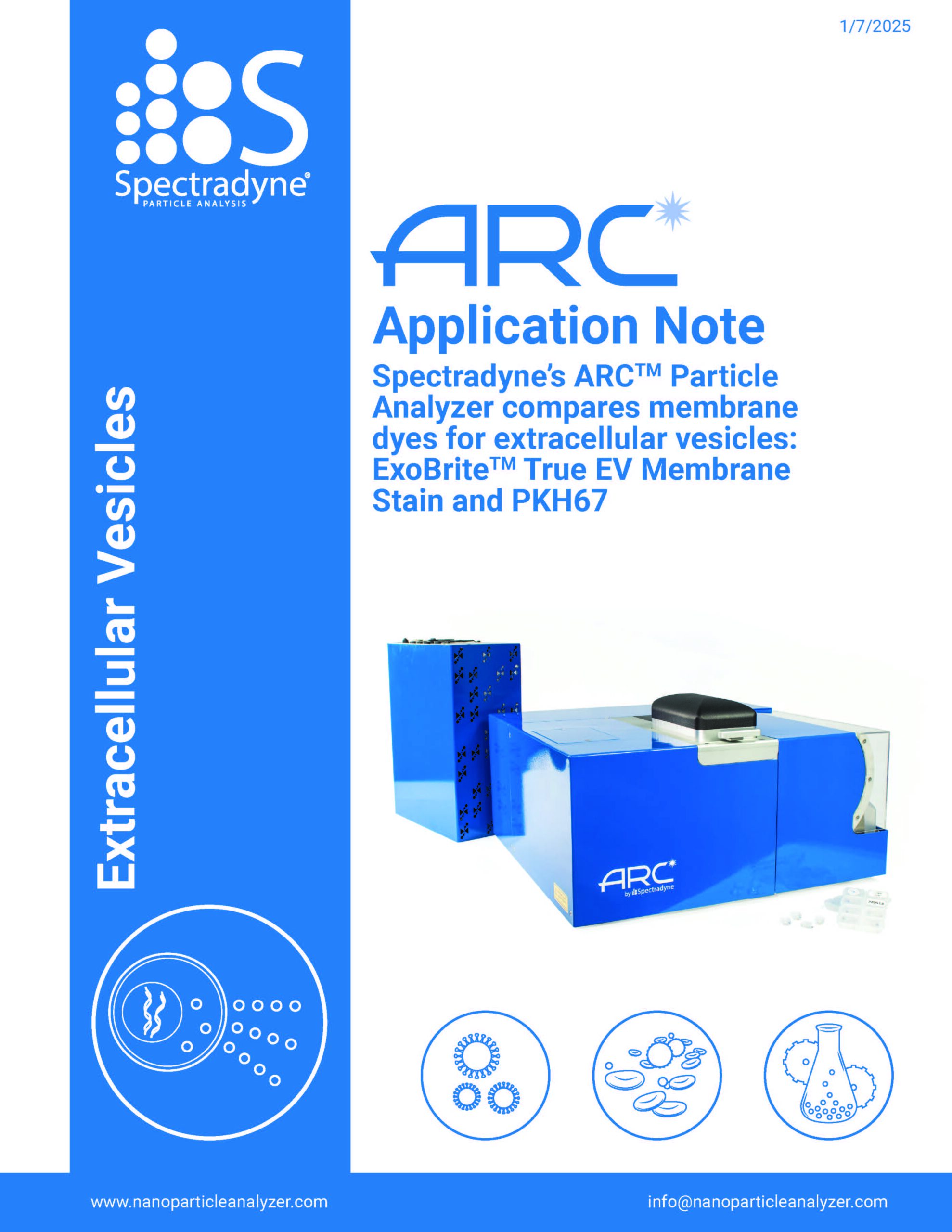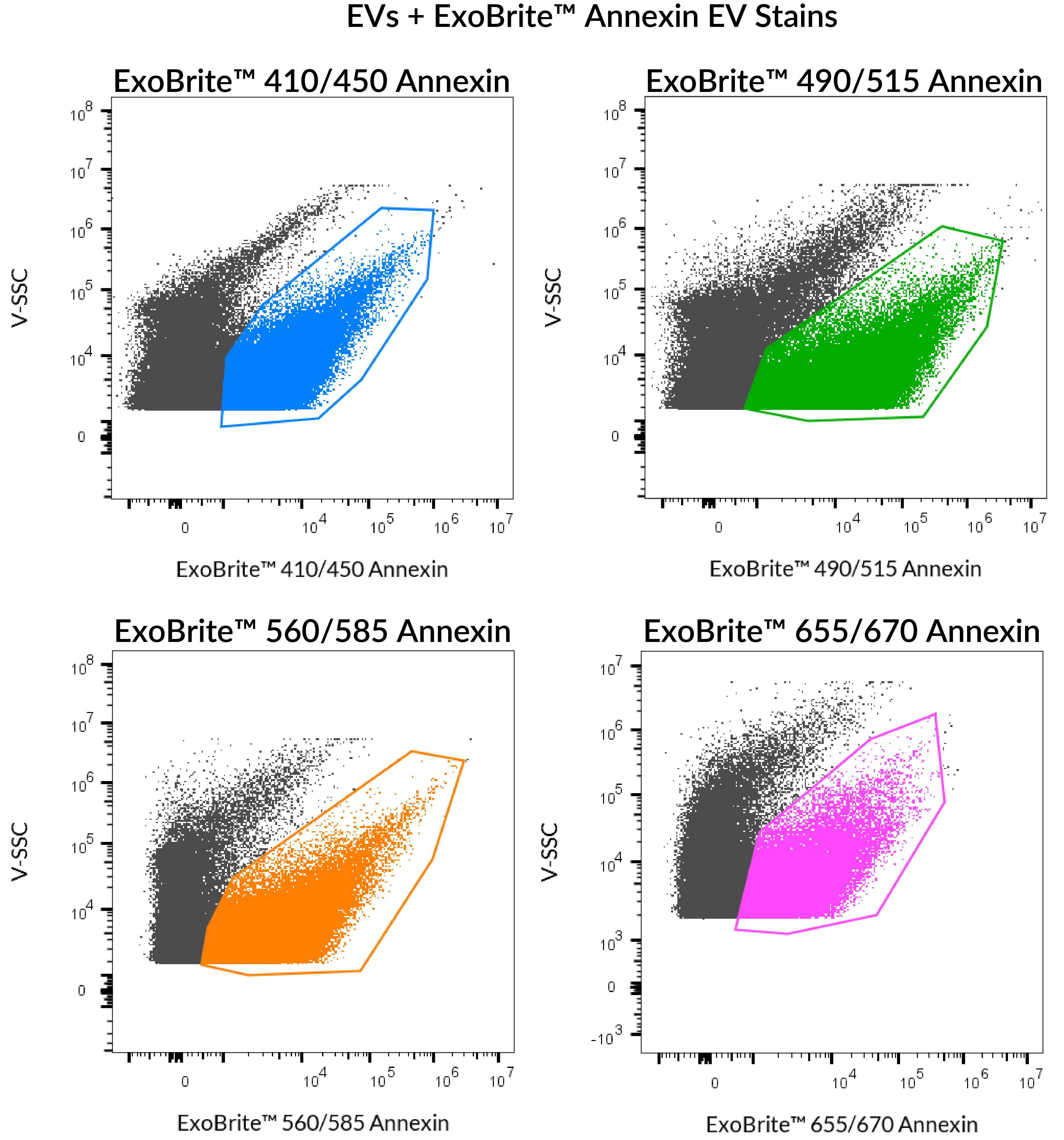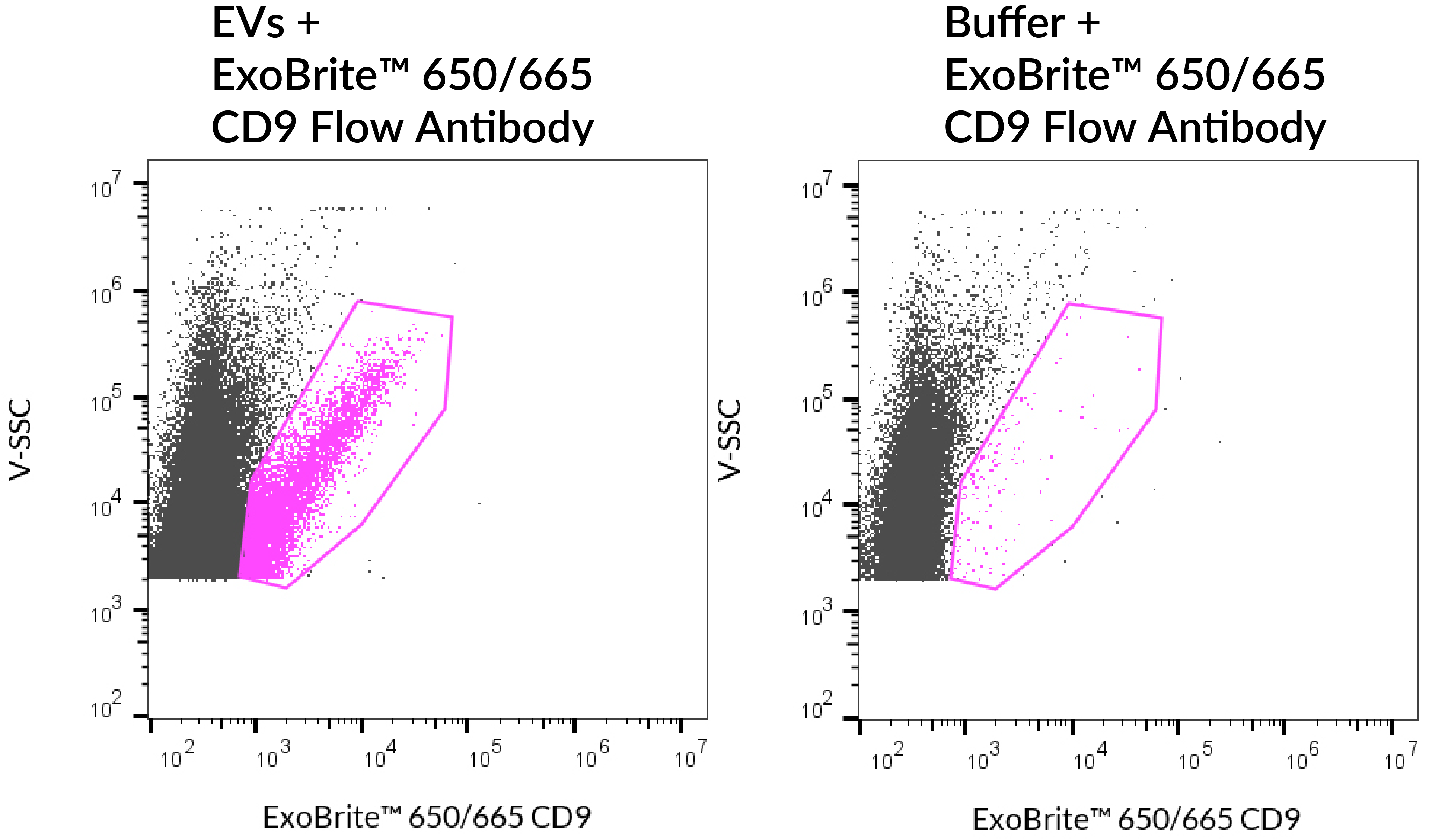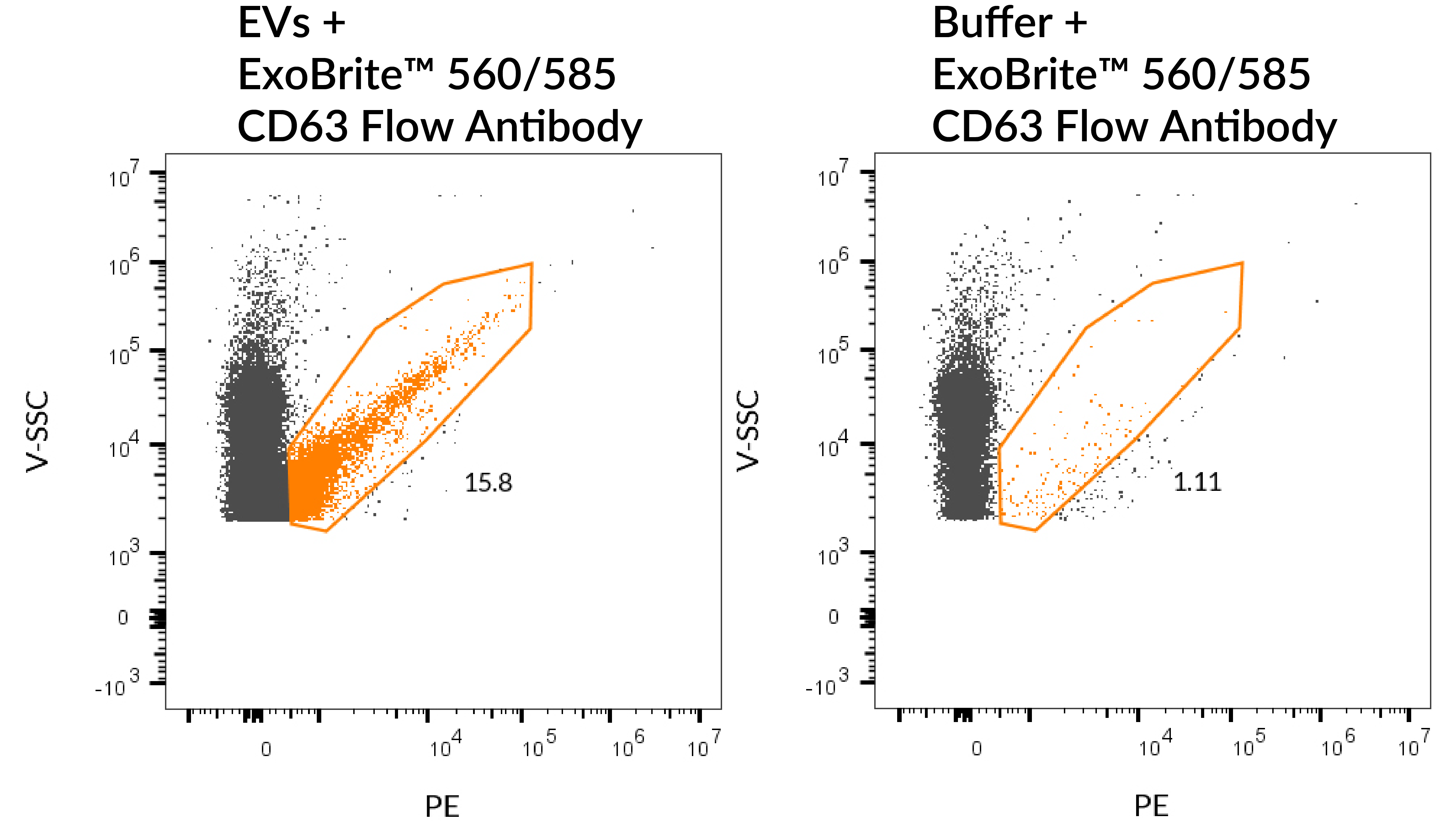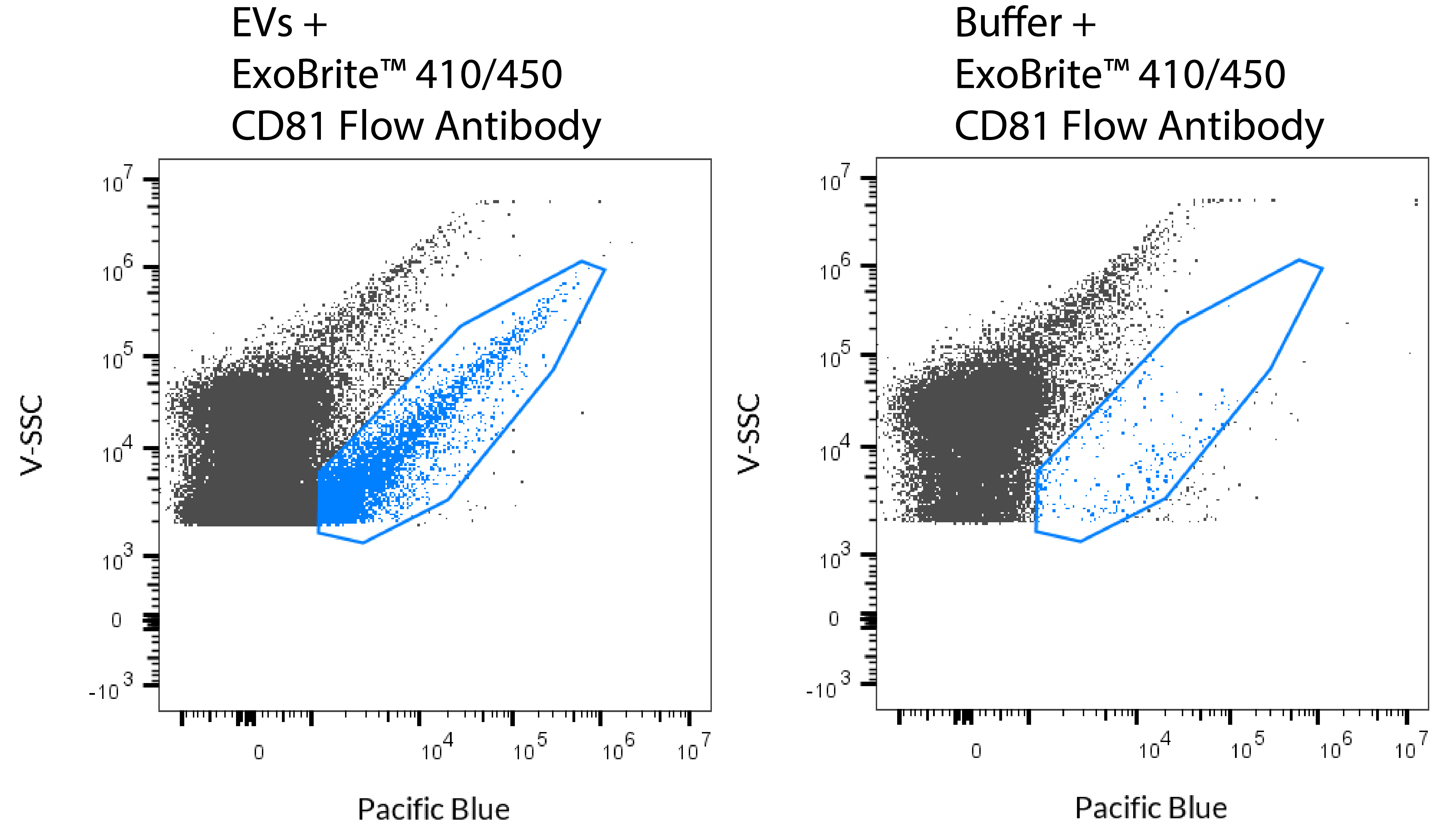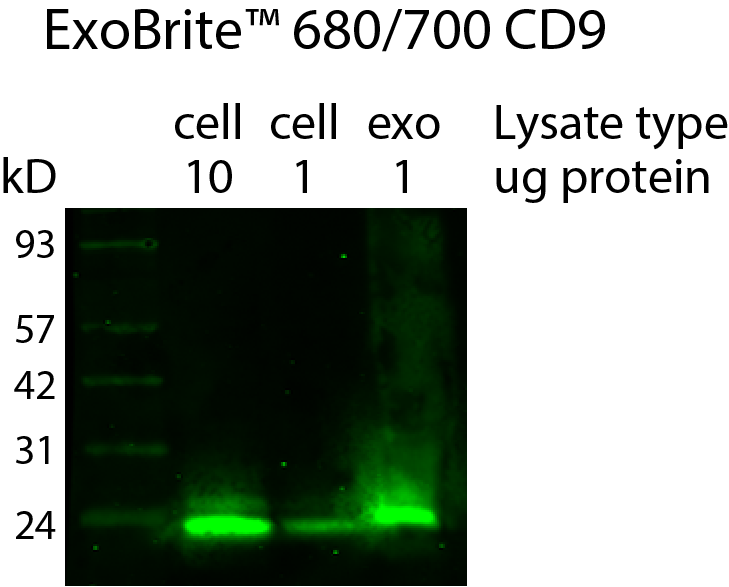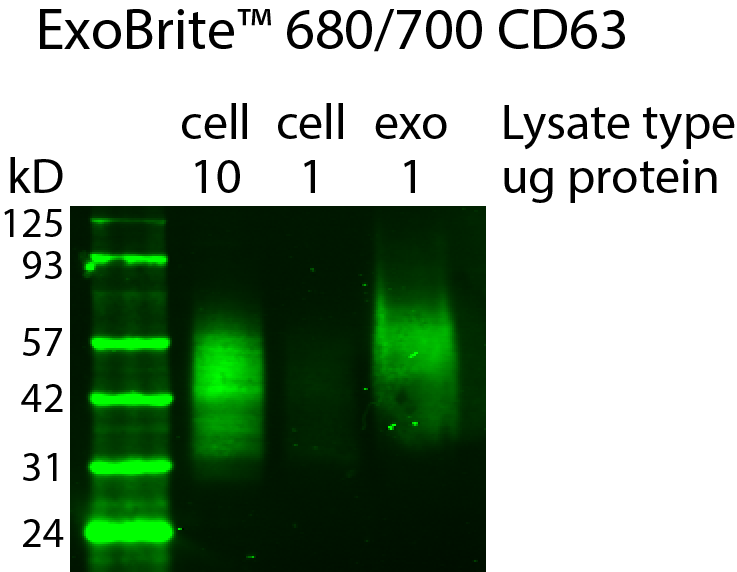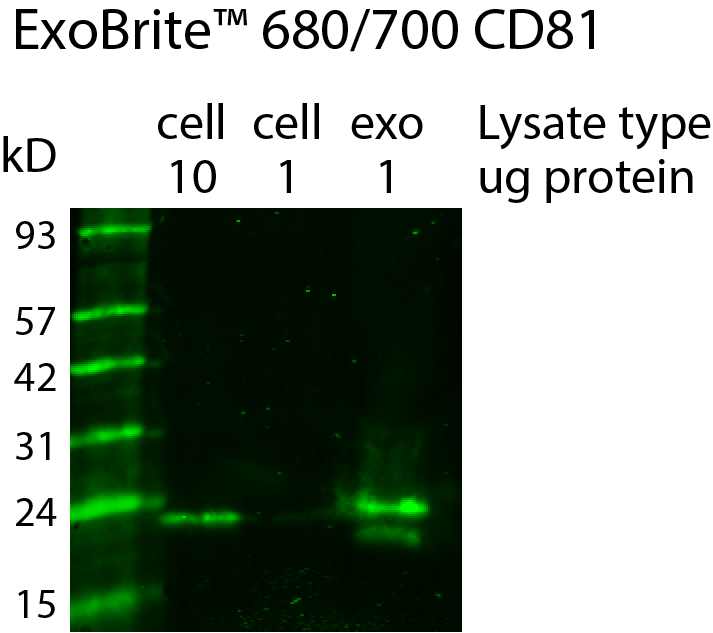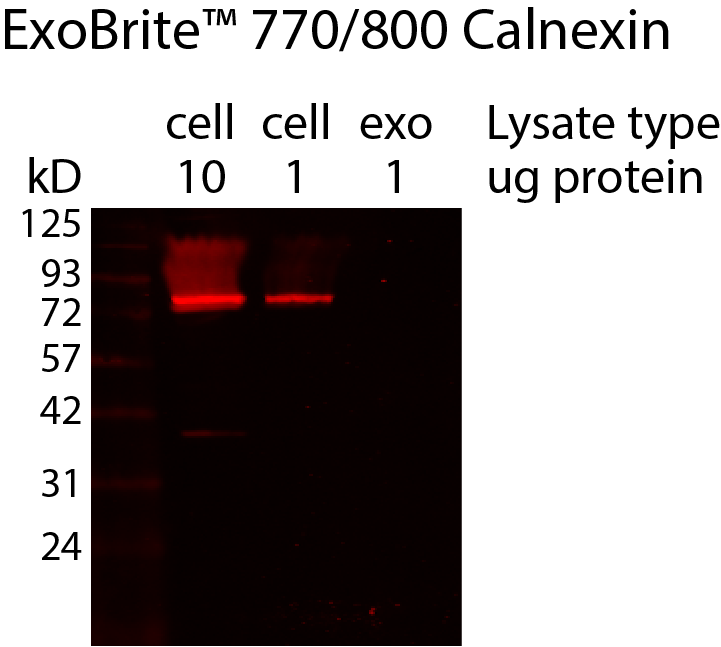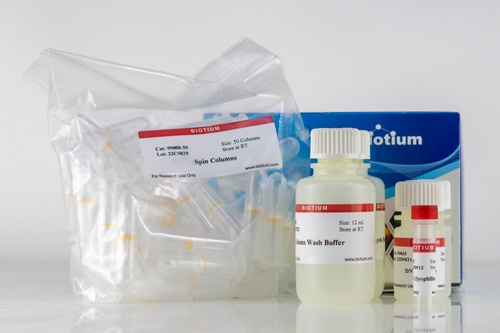EXOBRITE™ TRUE EV MEMBRANE STAINS
The Best Choice for Pan-EV Staining
ExoBrite™ True EV Membrane Stains are novel membrane dyes designed specifically for EV detection. While other membrane dyes like PKH, DiO, and DiI, are commonly used for labeling EVs, these dyes often have poor solubility and thus form aggregates that can be confused with EVs.
ExoBrite™ True EV Membrane Stains were designed specifically to address the issues of membrane dye aggregation and are the best choice for general pan-EV staining. They demonstrate higher (near-complete) coverage of EVs over competitor membrane dyes in fluorescence nanoparticle tracking analysis (fNTA). They also offer clear differentiation of EVs from non-specific particles during flow detection, which is not usually possible with other membrane dyes.
Advantages of ExoBrite™ True EV Membrane Stains
- Lipophilic membrane dyes designed for pan-EV labeling
- Superior alternative to common membrane dyes like PKH, DiO, DiI, DiD
- Bright signal with near-complete coverage of EVs in a sample
- Broad compatibility with EVs isolated from different sources
- Available in 4 colors for Pacific Blue®, FITC, PE, and APC channels
- Compatible with antibody co-staining
- Validated on Particle Metrix ZetaView® and Spectradyne ARC™ Particle Analyzer
Discover Superior EV Coverage and Signal-to-Noise Over PKH, DiO, and Other Membrane Dyes

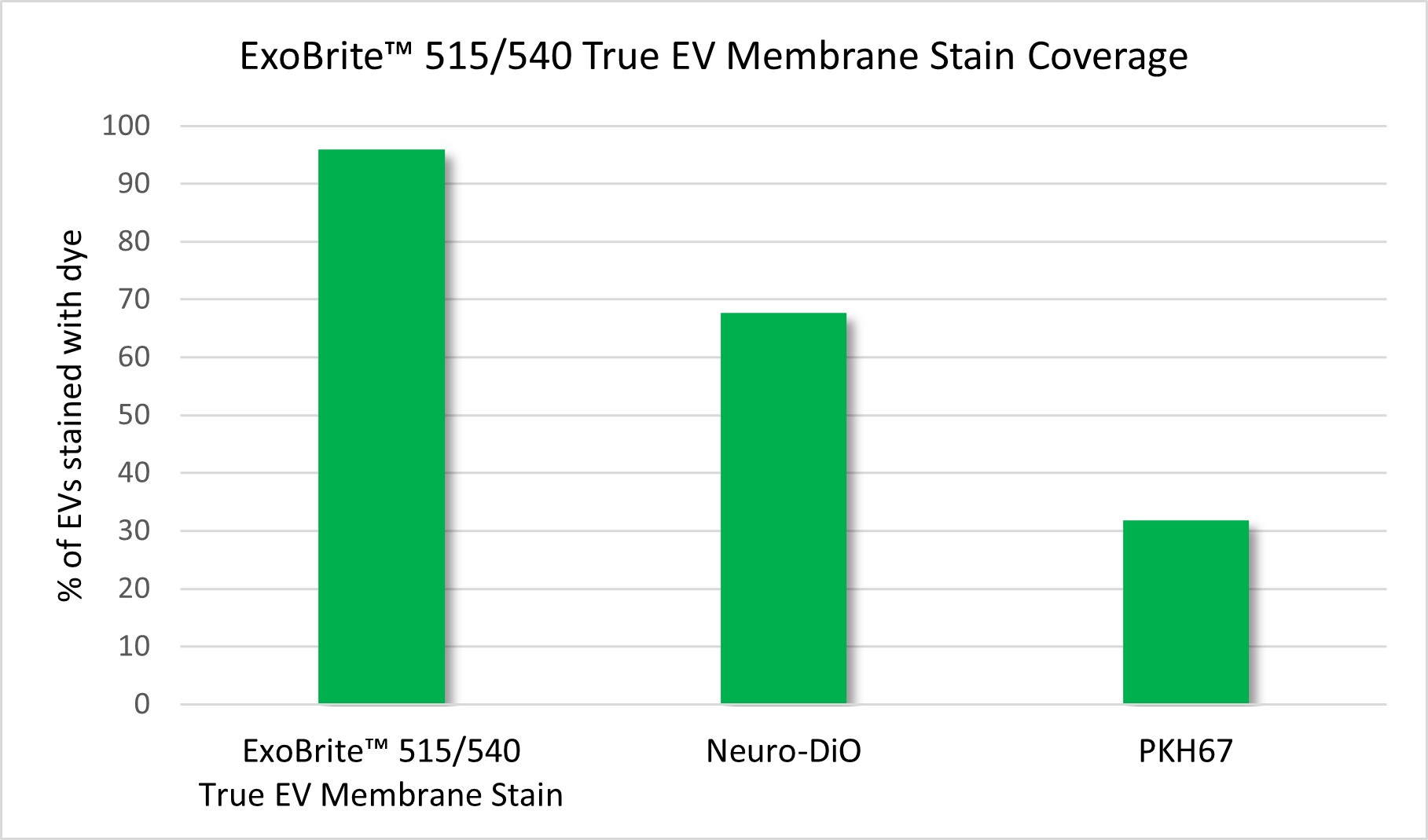
ExoBrite™ True EV Membrane Stain Outperforms PKH67 for EV Detection on ARC™ Particle Analyzer
In a collaboration between Biotium and Spectradyne, ExoBrite™ 515/540 True EV Membrane Stain and PKH67 were compared as membrane dyes for extracellular vesicles on the ARC™ Particle Analyzer.
Results demonstrate ExoBrite™ 515/540 True EV Membrane Stain is more effective at staining EVs and is less susceptible to dye aggregation than PKH67 membrane dye.
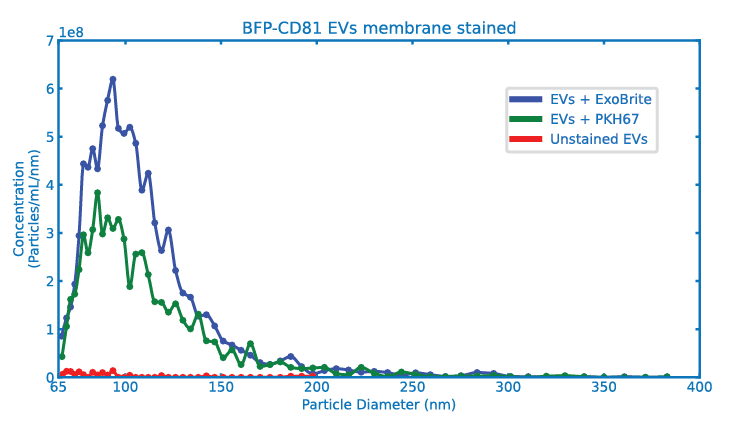
ExoBrite™ True EV Membrane Stains
| Product | Ex/Em | Detection Channels | Size | Catalog Number |
|---|---|---|---|---|
| ExoBrite™ 400/460 True EV Membrane Stain | 402/460 nm | Pacific Blue® | 100 Labelings | 30136-T |
| 500 Labelings | 30136 | |||
| ExoBrite™ 515/540 True EV Membrane Stain | 515/542 nm | FITC | 100 Labelings | 30129-T |
| 500 Labelings | 30129 | |||
| ExoBrite™ 555/575 True EV Membrane Stain | 556/576 nm | PE | 100 Labelings | 30130-T |
| 500 Labelings | 30130 | |||
| ExoBrite™ 645/675 True EV Membrane Stain | 644/671 nm | APC | 100 Labelings | 30137-T |
| 500 Labelings | 30137 |
Robust Stains Designed to Detect EVs, Not Dye Aggregates
Membrane dyes, while common tools for labeling EVs, can pose significant challenges when used for EV staining. For example, membrane dyes such as PKH, DiO, and DiI, have poor solubility and thus form aggregates that can be confused with EVs. To overcome these challenges, Biotium developed ExoBrite™ True EV Membrane Stains and ExoBrite™ EV Surface Stains (Annexin V, WGA, and CTB) to offer higher coverage and signal-to-noise over membrane dyes commonly used for EV staining. View our comparison table and validated EV sources below to select the best stain for your next experiment.
ExoBrite™ CTB, WGA, and Annexin Conjugates offer bright staining for reliable detection of EVs.
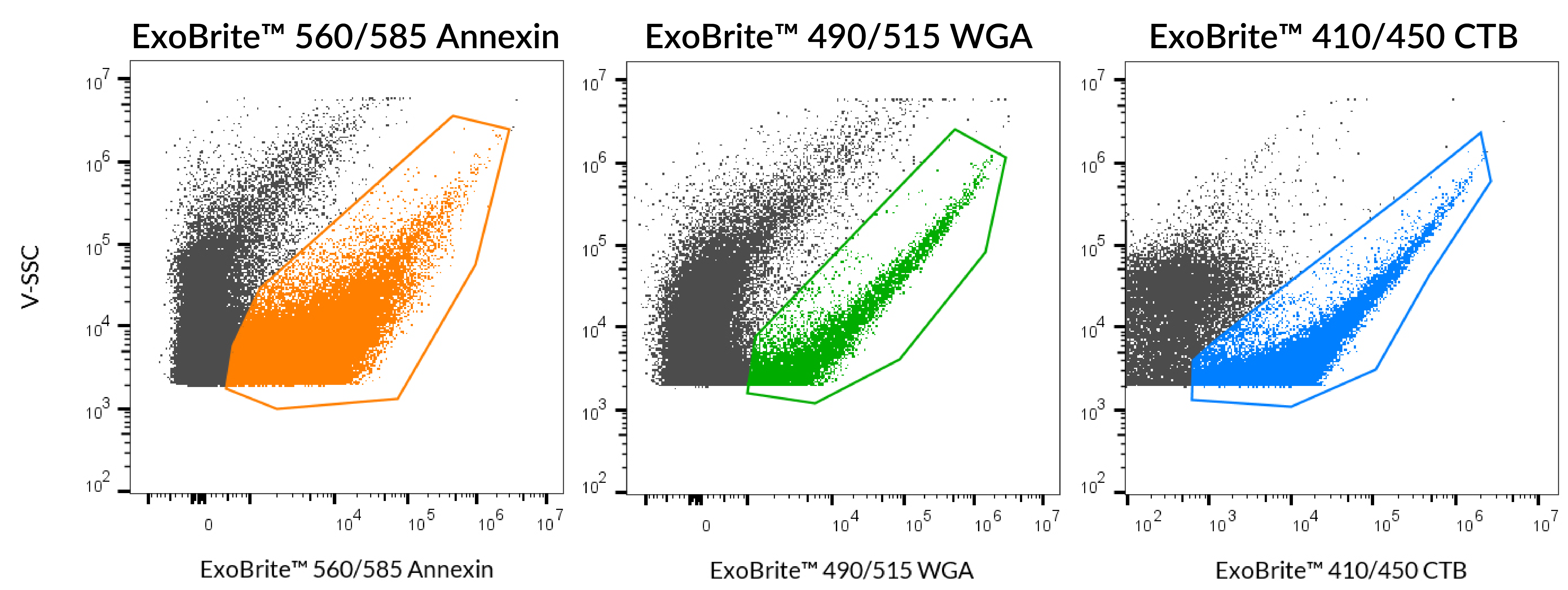
ExoBrite™ EV Stains Comparison Guide
| ExoBrite™ EV Surface Stain | Pros | Cons |
|---|---|---|
| ExoBrite™ True EV Membrane Stains | • Near-complete staining of EVs in a sample • Broad compatibility with different EV sources • Validated for flow and fNTA | • Can’t be used to stain bead-bound EVs • May have more aggregation than CTB & Annexin |
| ExoBrite™ Annexin EV Staining Kits | • Broad compatibility with different EV sources • Validated for flow and fNTA • Low background aggregates | • May not stain every EV in a sample • Doesn’t work well on bead-bound EVs |
| ExoBrite™ WGA EV Staining Kits | • Broad compatibility with different EV sources • Can be used with bead-bound EVs | • May not stain every EV in a sample • Doesn’t work well for fNTA |
| ExoBrite™ CTB EV Staining Kits | • Validated for flow and fNTA • Extremely low background | • May not stain every EV in a sample • Does not stain EVs from every source |
| ExoBrite™ Antibodies | • Highly specific for human tetraspanins CD9, CD63, or CD81 • Validated for EV flow • Broad compatibility for different EV sources • Can be used with bead-bound EVs • Can be used for WB | • Depends on the expression level of the target protein on the EVs |
ExoBrite™ EV Surface Stains
| Product | Conjugate | Detection channels | Size | Catalog Number |
|---|---|---|---|---|
| ExoBrite™ True EV Membrane Stains | N/A | FITC, PE | 100 Labelings, 500 Labelings | 30129, 30130 |
| ExoBrite™ Annexin EV Staining Kits | Annexin V | Pacific Blue™, FITC, PE, Cy®3, APC | 100 Labelings, 500 Labelings | 30119-30122 |
| ExoBrite™ WGA EV Staining Kits | Wheat Germ Agglutinin (WGA) | 30123-30126 | ||
| ExoBrite™ CTB EV Staining Kits | Cholera Toxin Subunit B (CTB) | 30111-30114 | ||
| ExoBrite™ EV Surface Stain Sampler Kit, Green | Annexin V, Wheat Germ Agglutinin (WGA), Cholera Toxin Subunit B (CTB) | FITC | 100 Labelings | 30127 |
| ExoBrite™ STORM CTB EV Staining Kits | Cholera Toxin Subunit B (CTB) | FITC, Texas Red®, Cy®5, Cy®5.5 | 100 Labelings, 500 Labelings | 30115-30118 |
Validated EV Sources for ExoBrite™ EV Surface Stains
| EV Source | ExoBrite™ True EV Membrane Stains | ExoBrite™ CTB Stains | ExoBrite™ WGA Stains | ExoBrite™ Annexin Stains |
|---|---|---|---|---|
| A549 cells | Yes | Yes | Yes | Yes |
| CHO cells | Yes | No | Yes | Yes |
| hASC (human adipose stem cells) | ND | No1 | ND | ND |
| HEK293T cells | ND | Yes1 | ND | ND |
| HeLa cells | Yes | No | Yes | Yes |
| HUVEC (human umbilical vein endothelial cells) | ND | No1 | ND | ND |
| J774 cells | Yes | Yes | Yes | Yes |
| Jurkat cells | Yes | Yes | Yes | Yes |
| MCF-7 cells | Yes | Yes | Yes | Yes |
| Plasma | ND | No | ND | Yes |
| Raji cells | ND | Yes | Yes | Yes |
| RAW 264.7 | Yes | ND | ND | ND |
| Serum | ND | No | ND | Yes |
| Skeletal myoblasts | ND | Yes1 | ND | ND |
| THP-1 | Yes | ND | ND | ND |
| U2OS cells | Yes | No | Yes | Yes |
| U937 cells | Yes | No | Yes | Yes |
Value of “Yes” or “No” indicates coverage of EVs based on Biotium’s internal data or customer-reported data. Value of “ND” indicates no data.
EXOBRITE™ ANNEXIN EV STAINING KITS
Bright & Sensitive EV Stains with Broad Compatibility
ExoBrite™ Annexin EV Staining Kits are uniquely formulated conjugates of Annexin V designed with broad compatibility for EVs derived from different sources. Similar to the ExoBrite™ CTB EV Stains, these Annexin V-based conjugates were developed for bright and sensitive staining of isolated EVs by flow cytometry with little to no background aggregation. ExoBrite™ Annexin EV Staining Kits also offer the broadest coverage for EVs. We tested EVs derived from 9 cell lines and ExoBrite™ Annexin EV Stains showed strong staining for all of them.
Advantages of ExoBrite™ Annexin EV Stains:
- Optimally formulated Annexin V conjugates for staining purified EVs
- Broad compatibility, stained EVs isolated from all 9 sources tested
- Bright signal and low background staining for flow cytometry
- Compatible with antibody co-staining
- Available in 4 colors for flexible experimental design
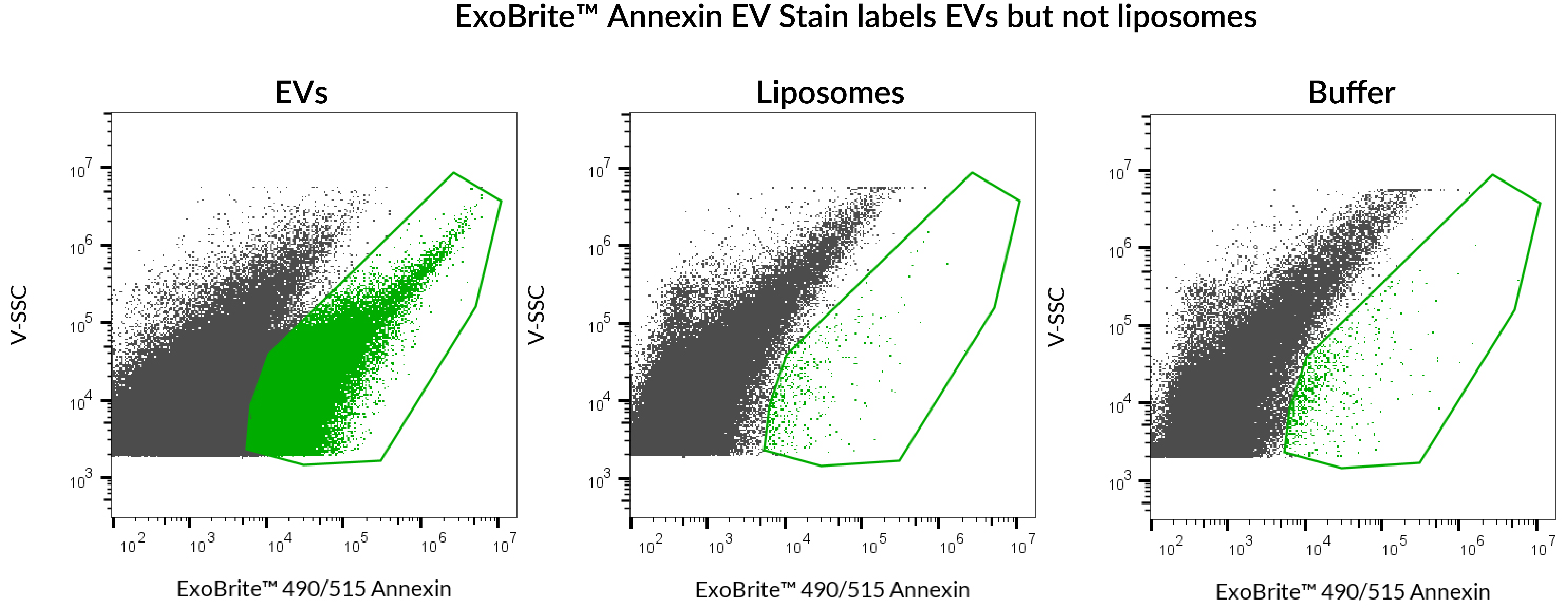
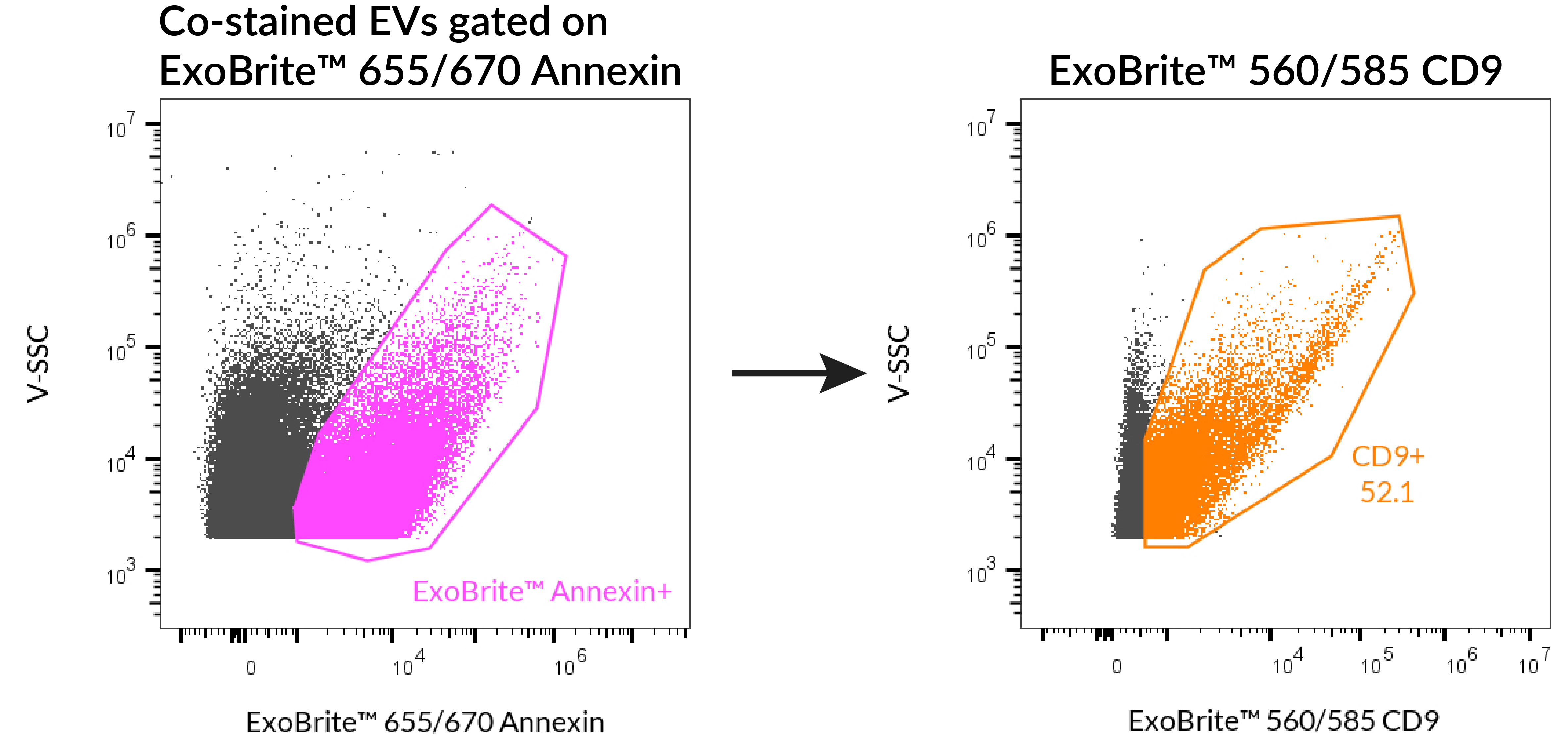
ExoBrite™ Annexin EV Staining Kits
| Product | Ex/Em | Detection channels | Size | Catalog Number |
|---|---|---|---|---|
| ExoBrite™ 410/450 Annexin EV Staining Kit | 416/452 nm | Pacific Blue™ | 100 Labelings | 30119-T |
| 500 Labelings | 30119 | |||
| ExoBrite™ 490/515 Annexin EV Staining Kit | 490/516 nm | FITC | 100 Labelings | 30120-T |
| 500 Labelings | 30120 | |||
| ExoBrite™ 560/585 Annexin EV Staining Kit | 562/584 nm | PE | 100 Labelings | 30121-T |
| 500 Labelings | 30121 | |||
| ExoBrite™ 650/665 Annexin EV Staining Kit | 652/668 nm | APC | 100 Labelings | 30122-T |
| 500 Labelings | 30122 |
EXOBRITE™ WGA EV STAINING KITS
Sensitive Stains for Purified or Bead-Bound EVs with Broad Compatibility
ExoBrite™ WGA EV Stains are fluorescent conjugates of wheat germ agglutinin (WGA) optimized for bright and sensitive staining of EVs. Similar to ExoBrite™ Annexin EV Stains, these WGA-based conjugates offer broad compatibility with EVs. The stains were validated for EVs derived from all 9 cell lines tested. In addition, ExoBrite™ WGA EV Stains are less prone to aggregation than hydrophobic membrane dyes and may be used to stain purified and bead-bound EVs.
Advantages of ExoBrite™ WGA EV Stains:
- Optimally formulated WGA conjugates for staining purified or bead-bound EVs
- Broad compatibility, stained EVs isolated from all 9 sources tested
- Bright signal and low background staining for flow cytometry
- Compatible with antibody co-staining
- Available in 4 colors for flexible experimental design
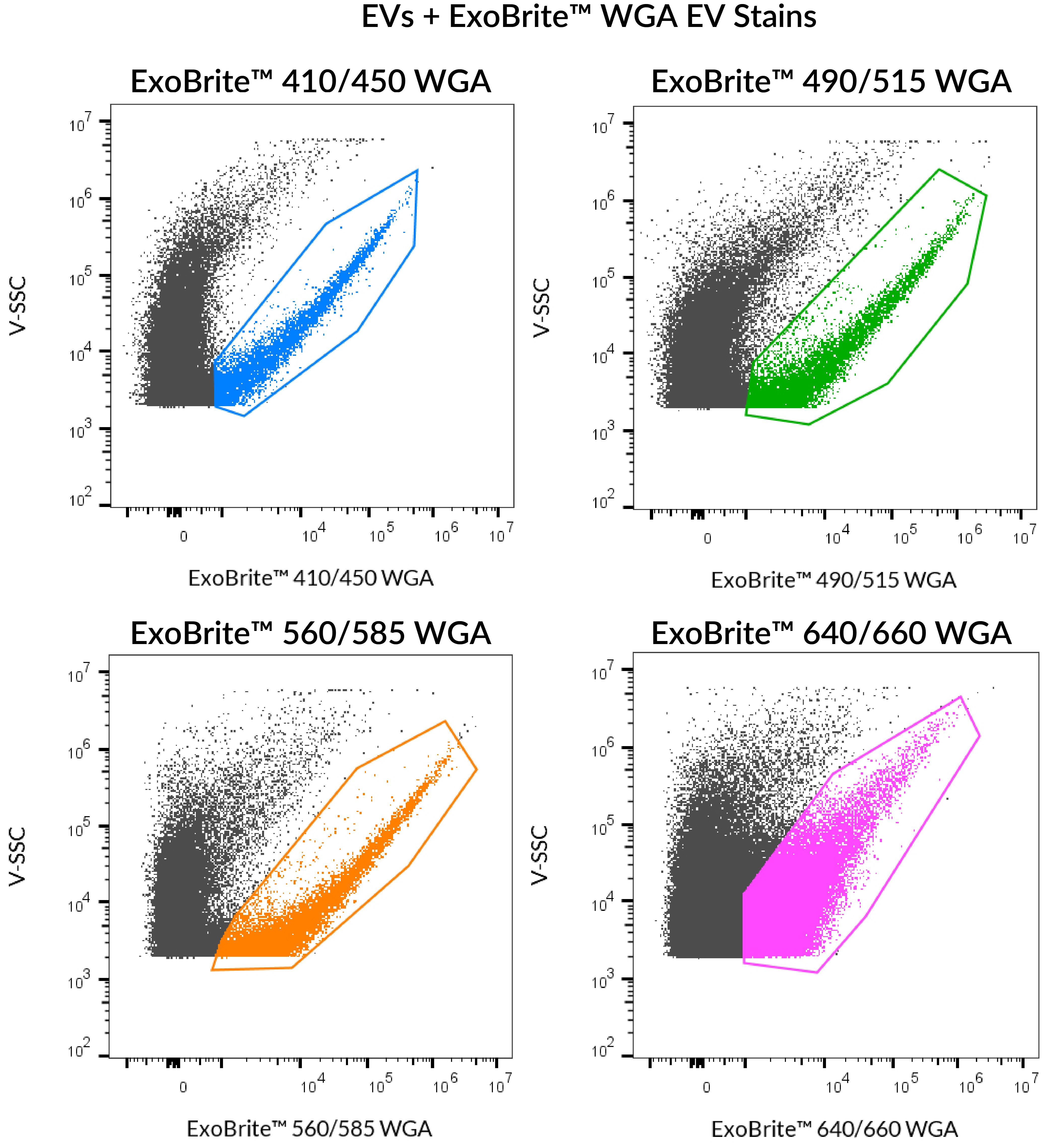
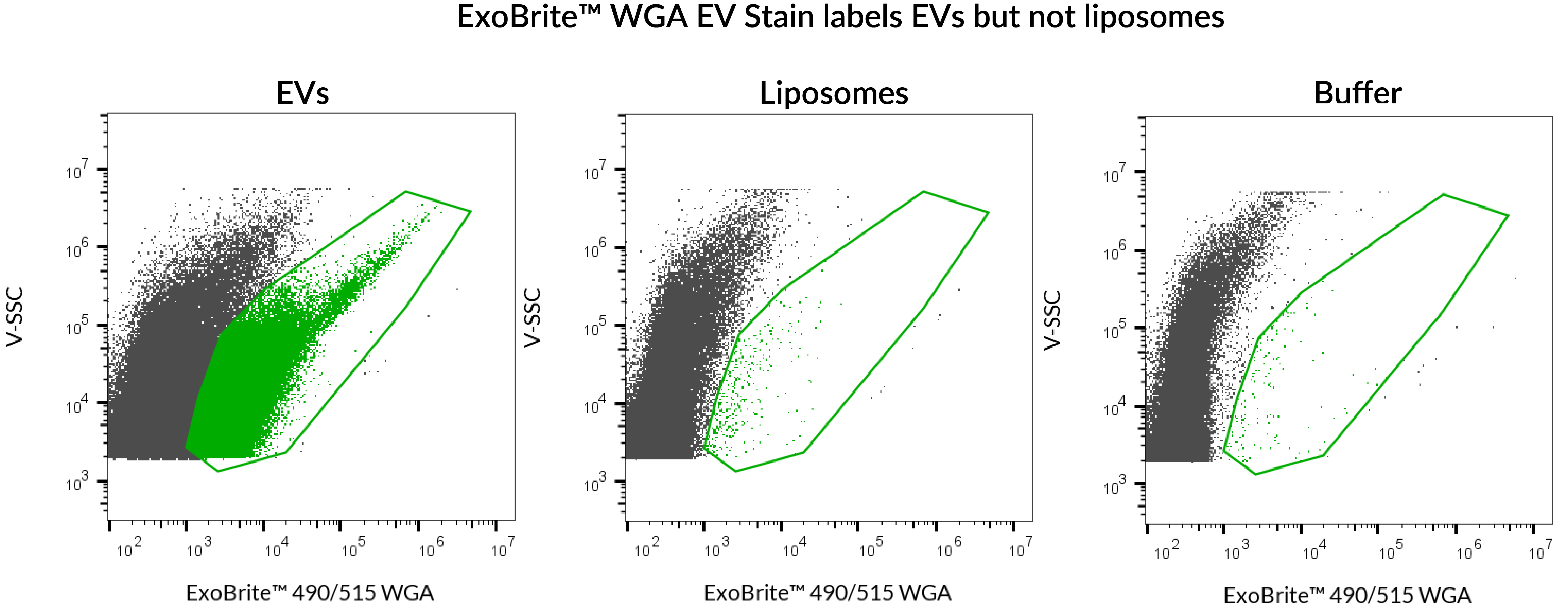
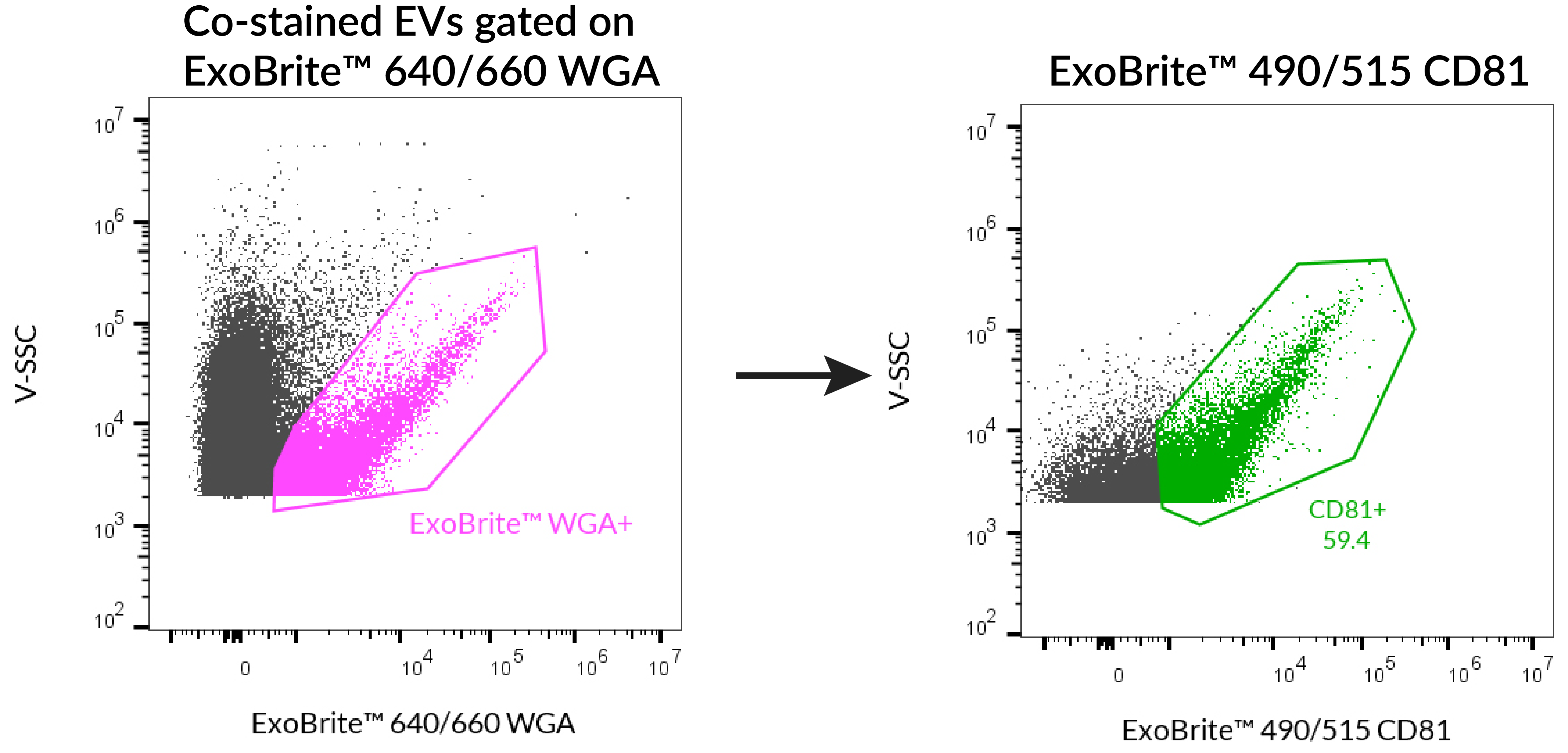
ExoBrite™ WGA EV Staining Kits
| Product | Ex/Em | Detection channels | Size | Catalog Number |
|---|---|---|---|---|
| ExoBrite™ 410/450 WGA EV Staining Kit | 416/452 nm | Pacific Blue™ | 100 Labelings | 30123-T |
| 500 Labelings | 30123 | |||
| ExoBrite™ 490/515 WGA EV Staining Kit | 490/516 nm | FITC | 100 Labelings | 30124-T |
| 500 Labelings | 30124 | |||
| ExoBrite™ 560/585 WGA EV Staining Kit | 562/584 nm | PE | 100 Labelings | 30125-T |
| 500 Labelings | 30125 | |||
| ExoBrite™ 640/660 WGA EV Staining Kit | 642/663 nm | APC | 100 Labelings | 30126-T |
| 500 Labelings | 30126 |
EXOBRITE™ CTB EV STAINING KITS
Bright EV Stains with Excellent Signal-to-Noise
ExoBrite™ CTB EV Staining Kits were designed to overcome some of the challenges of EV detection. ExoBrite™ stains bind to molecules in the EV membrane providing bright, specific staining of isolated EVs by flow cytometry. A key advantage of ExoBrite™ stains is that, unlike many other dyes, they show little to no background aggregates of a similar size as EVs. Also, unlike most membrane dyes, ExoBrite™ stains do not bind non-specifically to polystyrene beads, meaning that they can be used to stain bead-bound EVs.
Advantages of ExoBrite™ CTB EV Stains:
- Optimally formulated CTB conjugates for staining EVs
- Designed for detection by flow cytometry
- Bright fluorescence and low background for excellent signal-to-noise
- Compatible with antibody co-staining
- Stain purified or bead-bound EVs
- Available in 4 colors for flexible experimental design
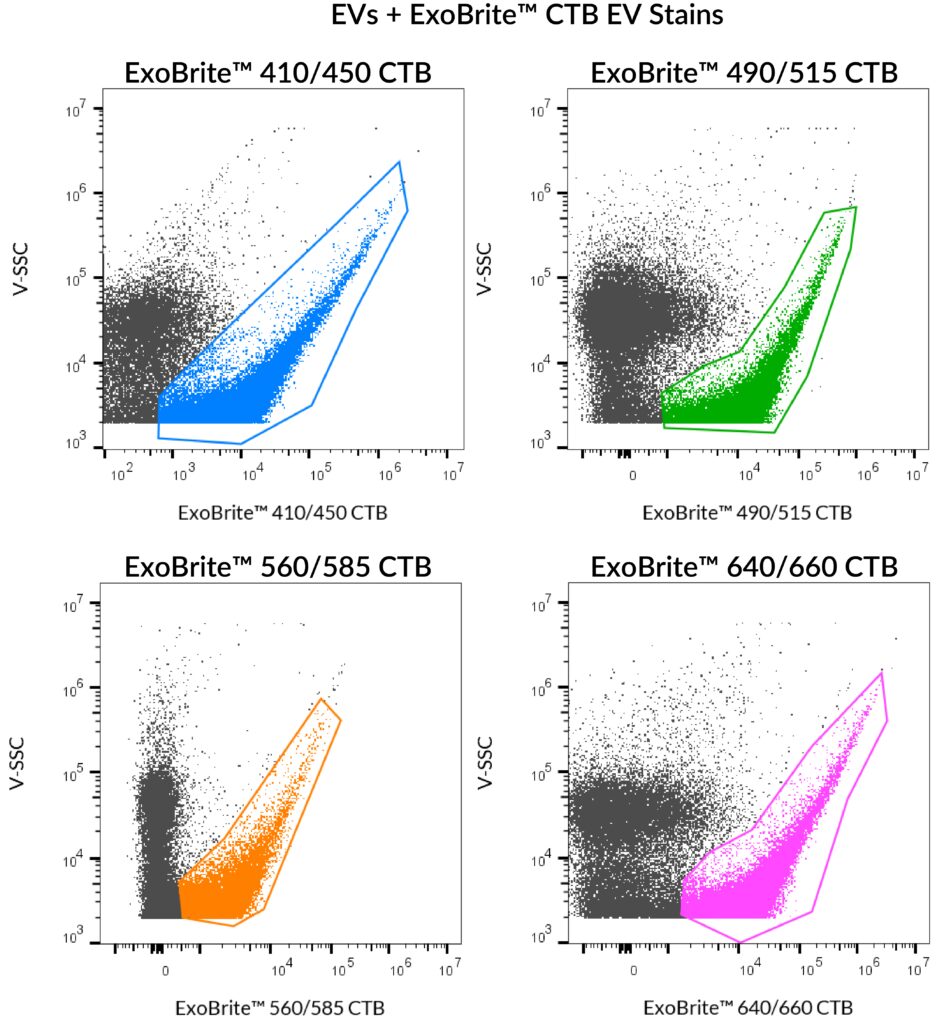
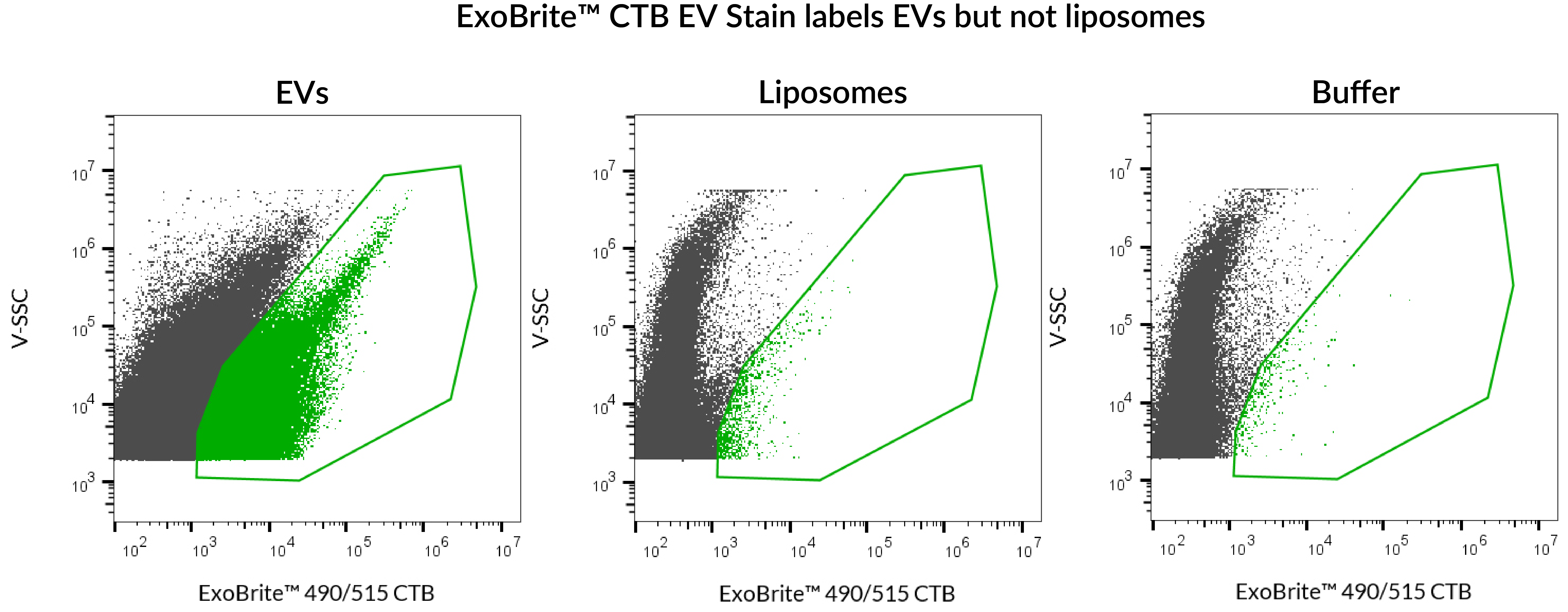
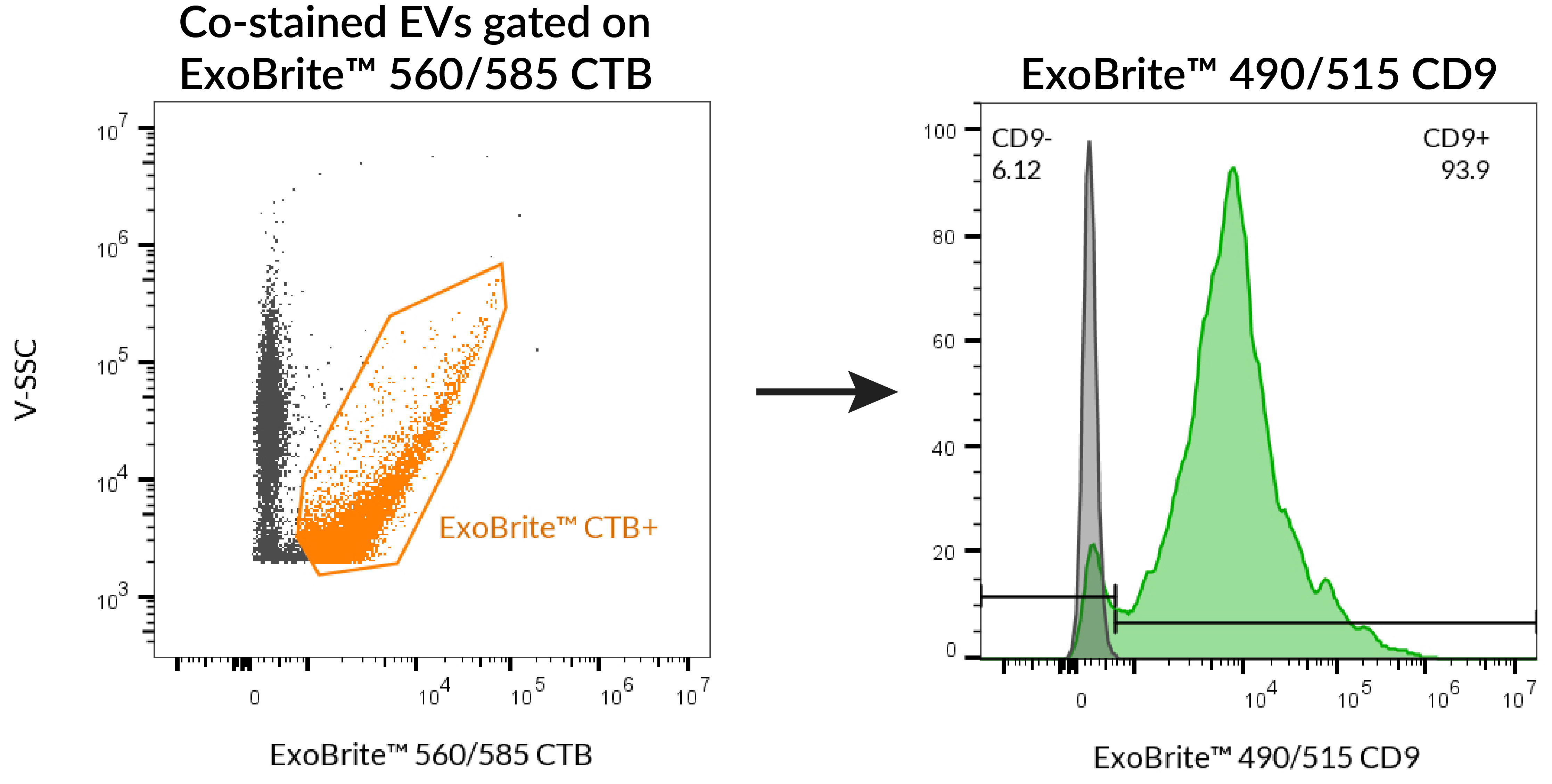
ExoBrite™ CTB EV Staining Kits
| Product | Ex/Em | Detection channels | Size | Catalog Number |
|---|---|---|---|---|
| ExoBrite™ 410/450 CTB EV Staining Kit | 416/452 nm | Pacific Blue™ | 100 Labelings | 30111-T |
| 500 Labelings | 30111 | |||
| ExoBrite™ 490/515 CTB EV Staining Kit | 490/516 nm | FITC | 100 Labelings | 30112-T |
| 500 Labelings | 30112 | |||
| ExoBrite™ 560/585 CTB EV Staining Kit | 562/584 nm | PE, Cy®3 | 100 Labelings | 30113-T |
| 500 Labelings | 30113 | |||
| ExoBrite™ 640/660 CTB EV Staining Kit | 642/663 nm | APC | 100 Labelings | 30114-T |
| 500 Labelings | 30114 |
CellMask is a trademark of Thermo Fisher Scientific; ExoFlow-ONE and ExoGlow are trademarks of System Biosciences.
ExoBrite™ EV Stain Enhancer
Significantly Improve Signal-to-Noise of Common EV Stains
The ExoBrite™ EV Stain Enhancer is a unique additive that can be added to extracellular vesicle (EV) stain reactions to improve the staining specificity for applications like flow cytometry. The ExoBrite™ Stain Enhancer works by reducing the aggregation of certain EV stains, which allows the conjugate to stain the EVs more efficiently, resulting in a better signal-to-noise ratio and fewer false positives.
Advantages of ExoBrite™ EV Stain Enhancer:
- Improves signal-to-noise by reducing or eliminating
aggregates of certain EV stains - Validated with several different lectins and Annexin V
- Does not interfere with antibody staining of EVs
- Easy to use, just add directly to the staining reaction
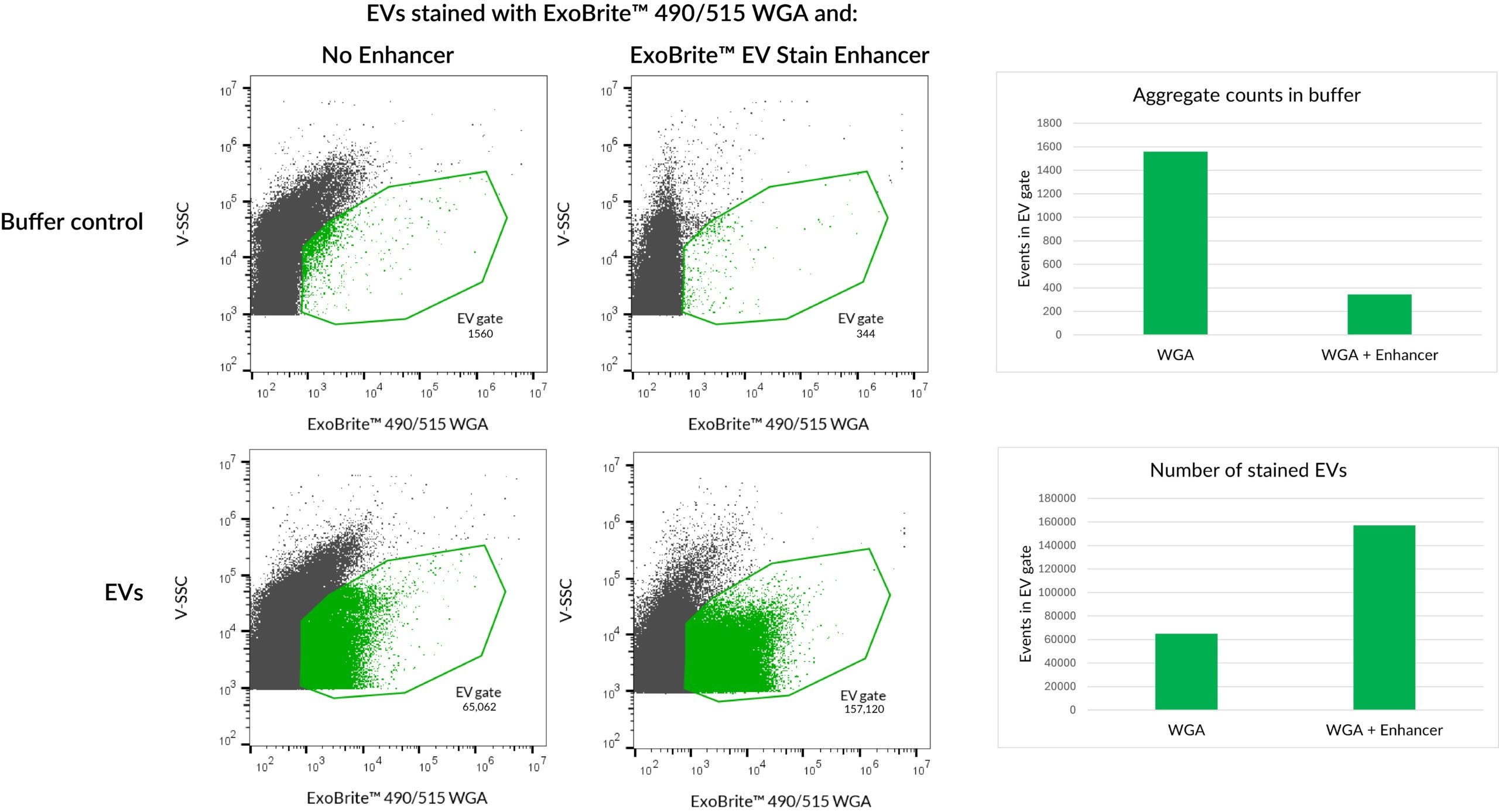
ExoBrite™ Flow Antibody Conjugates
Validated Antibodies for Detection of EV Markers by Flow Cytometry
The most common proteins used as EV markers are CD9, CD63, and CD81, members of the tetraspanin family. While antibodies targeting these proteins are available by commercial suppliers, few are validated or perform well for detection of EVs or exosomes. The antibodies and dye labels of ExoBrite™ Flow Antibody Conjugates were carefully selected and validated for robust detection of isolated EVs. In addition, the antibodies are provided in a proprietary buffer formulation for reduced antibody aggregation and brighter EV staining for optimal accuracy and signal-to-noise.
ExoBrite™ Isotype Control Flow Antibody, which have been found to not react with any target in human cells and have the same isotype as the tetraspanin antibodies, are also available as a negative control.
Advantages of ExoBrite™ Flow Antibodies:
- NEW: Now with updated buffer formulation for improved signal-to-noise
- Developed for detection of EV markers CD9, CD63, and CD81 by flow cytometry
- Validated for purified or bead-bound EVs
- Bright signal and low background
- ExoBrite™ Isotype Control Flow Antibody available
- Colors available for Pacific Blue™, FITC, PE, and APC channels
Purified EVs stained with ExoBrite™ Flow Antibodies
| Product | Conjugates | Detection Channels | Sizes | Catalog Number |
|---|---|---|---|---|
| ExoBrite™ CD9 Flow Antibody | ExoBrite™ 410/450 ExoBrite™ 490/515 ExoBrite™ 560/585 ExoBrite™ 640/660 ExoBrite™ R-PE ExoBrite™ APC | Pacific Blue ™ FITC PE APC | 25 tests 100 tests | P003-410… P003-RPE |
| ExoBrite™ CD9 (Mouse) Flow Antibody | ExoBrite™ 410/450 ExoBrite™ 490/515 ExoBrite™ 560/585 ExoBrite™ 640/660 | P018-410… P018-650 | ||
| ExoBrite™ CD63 Flow Antibody | ExoBrite™ 410/450 ExoBrite™ 490/515 ExoBrite™ 560/585 ExoBrite™ 640/660 ExoBrite™ R-PE ExoBrite™ APC | Pacific Blue ™ FITC PE APC | 25 tests 100 tests | P004-410… P004-RPE |
| ExoBrite™ CD63 (Mouse) Flow Antibody | ExoBrite™ 410/450 ExoBrite™ 490/515 ExoBrite™ 560/585 ExoBrite™ 640/660 | P022-410… P022-650 | ||
| ExoBrite™ CD81 Flow Antibody | ExoBrite™ 410/450 ExoBrite™ 490/515 ExoBrite™ 560/585 ExoBrite™ 640/660 ExoBrite™ R-PE ExoBrite™ APC | Pacific Blue ™ FITC PE APC | 25 tests 100 tests | P005-410… P005-RPE |
| ExoBrite™ CD81 (Mouse/Rat) Flow Antibody | ExoBrite™ 410/450 ExoBrite™ 490/515 ExoBrite™ 560/585 ExoBrite™ 640/660 | P019-410… P019-650 | ||
| ExoBrite™ IgG1 Isotype Control Flow Antibody | ExoBrite™ 410/450 ExoBrite™ 490/515 ExoBrite™ 560/585 ExoBrite™ 640/660 ExoBrite™ R-PE | Pacific Blue ™ FITC PE APC | 25 tests 100 tests | P008-410… P008-RPE |
ExoBrite™ Antibody Cocktails
Streamline Your Workflows with High-Coverage EV Staining
or Robust Phenotype Analysis
Biotium’s ExoBrite™ CD9/CD63/CD81 Antibody Cocktails are antibody mixtures developed with optimal brightness and signal-to-noise for detecting EVs. The single-color cocktails were developed for high-coverage EV antibody staining by flow cytometry. For phenotyping analysis, the 3-color cocktails provide distinct fluorescent labels for each marker, enabling multiplexed detection and comprehensive profiling of extracellular vesicles. Both cocktails were validated by flow cytometry for low aggregation and high signal-to-noise.
Advantages of ExoBrite™ Antibody Cocktails:
- Single-color cocktails designed for high-coverage EV staining
- 3-color cocktail designed for phenotyping analysis
- Each antibody is optimized to offer the brightest signal
- Formulated for low aggregation, high signal-to-noise
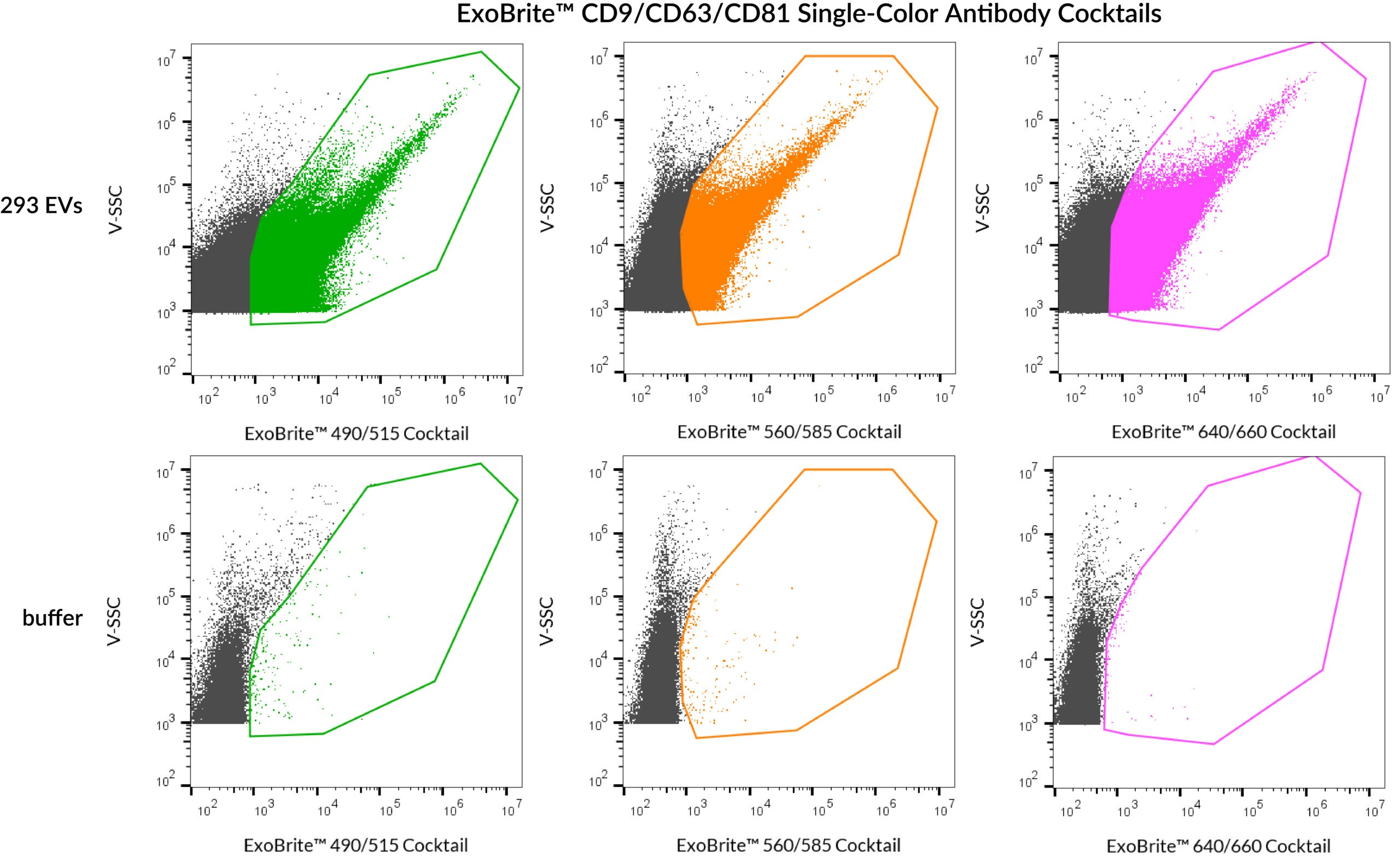
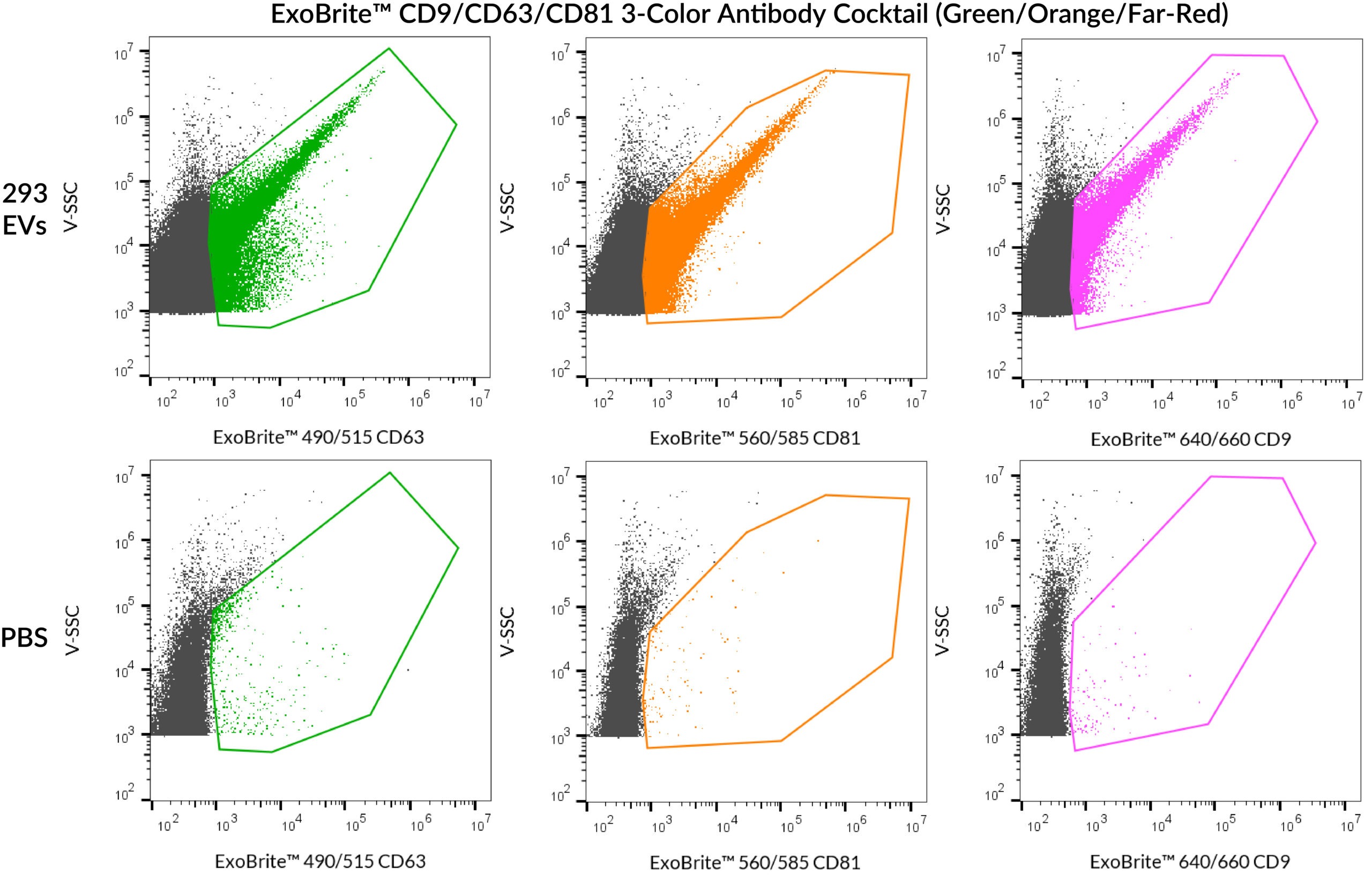
ExoBrite™ Flow Anti-Human CD9/CD63/CD81 Antibody Cocktails
| Cocktail | Ex/Em | Detection Channel | Size | Catalog No. |
|---|---|---|---|---|
| ExoBrite™ CD9/CD63/CD81 Single-Color Antibody Cocktail (Green) | 490/516 nm | FITC | 25 tests | P030-125 |
| 100 tests | P030-500 | |||
| ExoBrite™ CD9/CD63/CD81 Single-Color Antibody Cocktail (Orange) | 562/584 nm | PE | 25 tests | P031-125 |
| 100 tests | P031-500 | |||
| ExoBrite™ CD9/CD63/CD81 Single-Color Antibody Cocktail (Far-Red) | 642/663 nm | APC | 25 tests | P032-125 |
| 100 tests | P032-500 | |||
| ExoBrite™ CD9/CD63/CD81 3-Color Antibody Cocktail (Blue/Green/Far-Red) | 490/516 nm 562/584 nm 642/663 nm | FITC PE APC | 25 tests | P028-125 |
| 100 tests | P028-500 | |||
| ExoBrite™ CD9/CD63/CD81 3-Color Antibody Cocktail (Green/Orange/Far-Red) | 25 tests | P029-125 | ||
| 100 tests | P029-500 |
ExoBrite™ Streptavidin Magnetic Beads
Convenient & Optimized Capture of EVs
Streamline your EV and exosome isolation workflows with ExoBrite™ Streptavidin Magnetic Beads, developed to offer lower background and higher sensitivity for EV capture than similar products. These streptavidin-coated and magnetic polystyrene beads (4.5 um diameter) may be used to isolate EVs from cell culture medium or other biological fluids without an overnight precipitation step.
Advantages of ExoBrite™ Streptavidin Magnetic Beads:
- Combine with a biotinylated antibody (not included) for isolation of EVs
- Isolate EVs from biofluids without an overnight precipitation step
- Lower background and higher sensitivity than competitors
- Convenient magnetic-based separation
- Detect downstream with microscopy, flow cytometry, or western blot
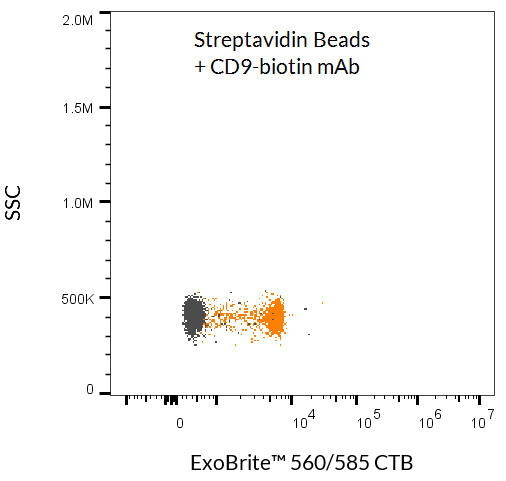
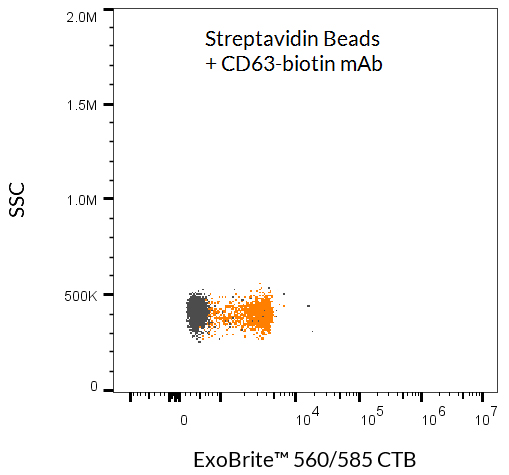
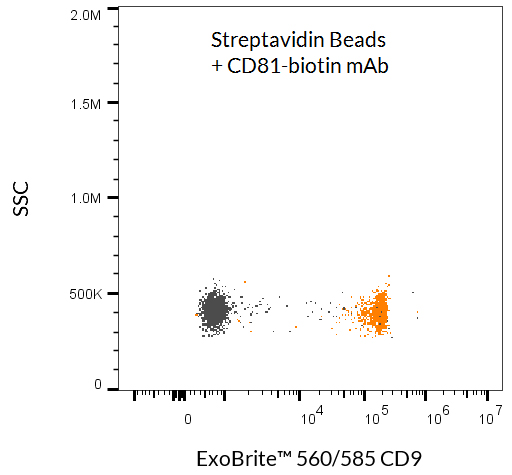
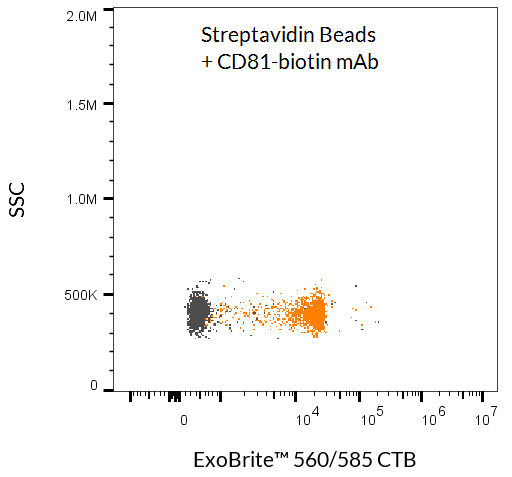
SUPER-RESOLUTION IMAGING
High-Performance EV Stains for Super-Resolution
Featuring STORM-Optimized CF® Dyes
Characterizing exosomes and EVs by imaging is challenging due to their small size and the resolution limits of conventional light microscopy. Super-resolution techniques like direct stochastic optical reconstruction microscopy (dSTORM) overcome these limits, providing single-molecule resolution of subcellular structures such as EVs. This enables deeper insights into EV biogenesis, behavior, and morphology.
ExoBrite™ STORM Antibodies and CTB EV Stains harness CF® Dyes optimized for STORM imaging, delivering ultra-bright, high-resolution EV imaging. The ExoBrite™ STORM Antibodies are formulated for detecting EV markers with high signal-to-noise, while ExoBrite™ STORM CTB EV Stains enable sharp, specific membrane labeling via cholera toxin subunit B. These advanced reagents provide exceptional clarity for STORM imaging.
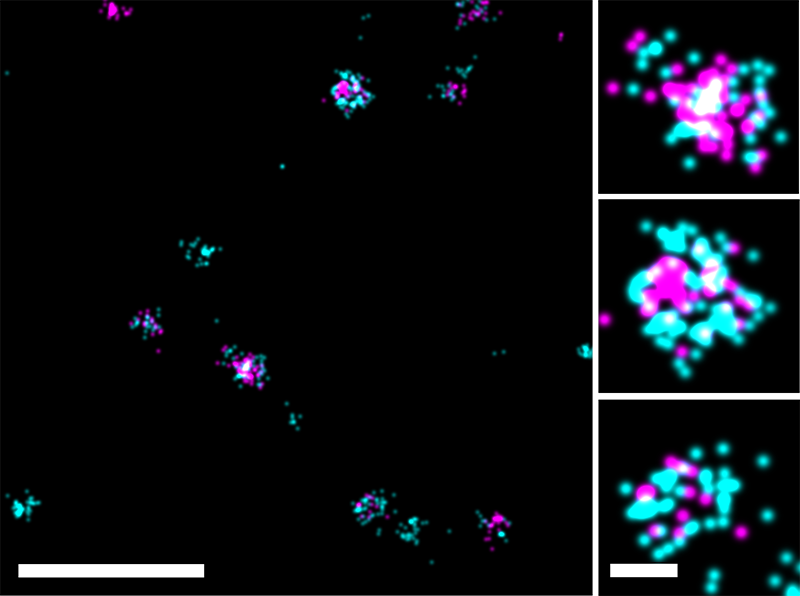
Advantages of ExoBrite™ STORM Antibodies
- Validated antibodies for detecting EV markers CD9, CD63, and CD81
- Available with excellent STORM dyes
CF®498, CF®568, CF®583R, and CF®647Plus - Proprietary buffer for enhanced signal-to-noise
- Available in 4 colors for FITC, Cy®3, Texas Red®, and Cy®5 channels
Advantages of ExoBrite™ STORM CTB EV Stains:
- Optimally formulated CTB conjugates for imaging EVs by STORM
- Available with excellent STORM dyes CF®505, CF®583R, CF®647, and CF®680
- Allows antibody co-staining and localization studies with EV biomarkers
Note: ExoBrite™ CTB stains have been found to label EVs derived from several tested cell lines, but may not stain EVs from every source. Please visit the product page to view a full list of validated EV sources.
ExoBrite™ STORM Antibodies
| Antibody | Conjugates | Detection Channels | Catalog Number |
|---|---|---|---|
| ExoBrite™ STORM CD9 Antibody | CF®498 CF®568 CF®583R CF®647Plus | FITC Cy®3 Texas Red® Cy®5 | P003-498ST-500 P003-568ST-500 P003-583RST-500 P003-647PST-500 |
| ExoBrite™ STORM CD63 Antibody | CF®498 CF®568 CF®583R CF®647Plus | FITC Cy®3 Texas Red® Cy®5 | P004-498ST-500 P004-568ST-500 P004-583RST-500 P004-647PST-500 |
| ExoBrite™ STORM CD81 Antibody | CF®498 CF®568 CF®583R CF®647Plus | FITC Cy®3 Texas Red® Cy®5 | P005-498ST-500 P005-568ST-500 P005-583RST-500 P005-647PST-500 |
| ExoBrite™ STORM CD9 (Mouse) Antibody | CF®568 CF®647Plus | Cy®3 Cy®5 | P018-568ST-500 P018-647PST-500 |
| ExoBrite™ STORM CD63 (Mouse) Antibody | CF®568 CF®647Plus | Cy®3 Cy®5 | P022-568ST-500 P022-647PST-500 |
| ExoBrite™ STORM CD81 (Mouse/Rat) Antibody | CF®568 CF®647Plus | Cy®3 Cy®5 | P019-568ST-500 P019-647PST-500 |
ExoBrite™ STORM CTB EV Staining Kits
| Product | Ex/Em (nm) | Laser Line(s) (nm) | Detection Channel | Size | Catalog Number |
|---|---|---|---|---|---|
| ExoBrite™ STORM CF®505 CTB EV Staining Kit | 505/519 | 488 | FITC | 100 Labelings | 30115-T |
| 500 Labelings | 30115 | ||||
| ExoBrite™ STORM CF®583R CTB EV Staining Kit | 583/609 | 555 or 561 | Rhodamine or Texas Red® | 100 Labelings | 30116-T |
| 500 Labelings | 30116 | ||||
| ExoBrite™ STORM CF®647 CTB EV Staining Kit | 652/668 | 633-640 | Cy®5 | 100 Labelings | 30117-T |
| 500 Labelings | 30117 | ||||
| ExoBrite™ STORM CF®680 CTB EV Staining Kit | 681/698 | 633-640 | Cy®5.5 | 100 Labelings | 30118-T |
| 500 Labelings | 30118 |
ExoBrite™ Western Antibody Conjugates
Validated Antibodies for Detection of EV Markers by Western Blotting
ExoBrite™ Western Antibodies were validated to offer bright signal and low background of EV markers CD9, CD63, and CD81 in EV extracts by near-IR fluorescent western blot. The antibodies are available with two near-infrared fluorescent dyes, ExoBrite™ 680/700 and ExoBrite™ 770/800, which offer greater signal-to-noise than dyes with visible light emission for western blotting.
An ExoBrite™ Calnexin Western Antibody detects a protein of the endoplasmic reticulum that is not found in EVs. It is offered as a negative control to assess the purity of isolated EV extracts.
Advantages of ExoBrite™ Western Antibodies:
- Developed for detection of EV markers CD9, CD63, and CD81 by fluorescent western blot
- Validated for use with EV extracts
- Bright signal and low background
- Available in 2 near-infrared colors
- Negative control ExoBrite™ Calnexin Western Antibody available
| Product | Conjugates | Sizes | Catalog Number |
|---|---|---|---|
| ExoBrite™ CD9 Western Antibody | ExoBrite™ 680/700 ExoBrite™ 770/800 | 25 tests 100 tests | P003-680, P003-770 |
| ExoBrite™ CD63 Western Antibody | P004-680, P004-770 | ||
| ExoBrite™ CD81 Western Antibody | P006-680, P006-770 | ||
| ExoBrite™ Calnexin Western Antibody | ExoBrite™ 770/800 | P007-770 |
TOTAL RNA EXTRACTION
Efficient Total RNA Extraction from Purified EVs
The ExoBrite™ EV Total RNA Isolation Kit was designed to address the challenges of EV RNA extraction by offering an optimized and easy-to-use kit for total RNA isolation, including mRNA and miRNAs, from purified EVs. The isolated EV RNA can then be used for downstream analysis such as qPCR or RNAseq.
Advantages of ExoBrite™ EV Total RNA Isolation Kit:
- Optimized for total RNA extraction from purified EVs
- Recover ~10-20 ng of RNA from 1×1010 SEC-enriched EVs
- Compatible with downstream applications such as qPCR or RNAseq
- Simple column-based purification
- No phenol/chloroform or ethanol precipitation steps
Helpful Resources on EV Isolation & Detection
Tech Tip: Exosome Isolation and Staining Protocols
In this Tech Tip, Biotium scientists provide detailed protocols for isolating EVs from cell supernatants using PEG precipitation or size exclusion chromatography (SEC).

